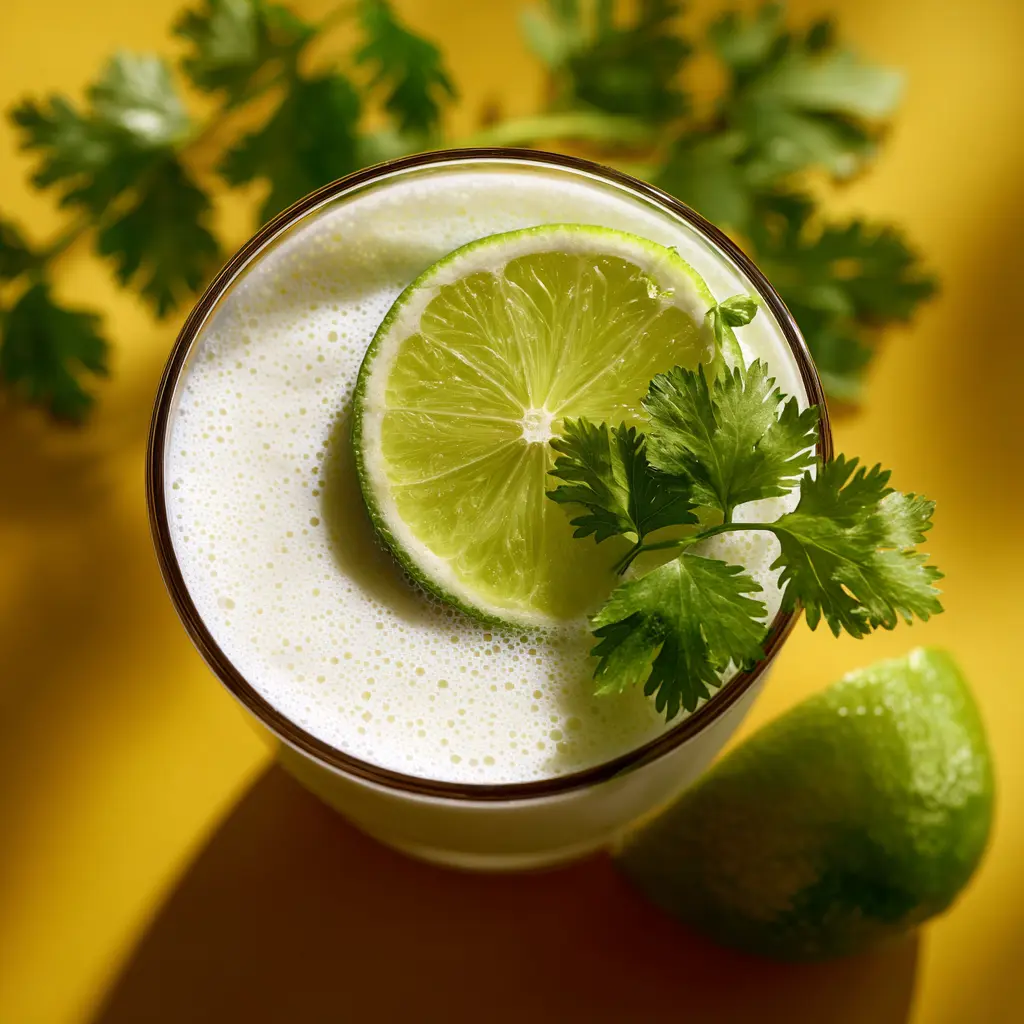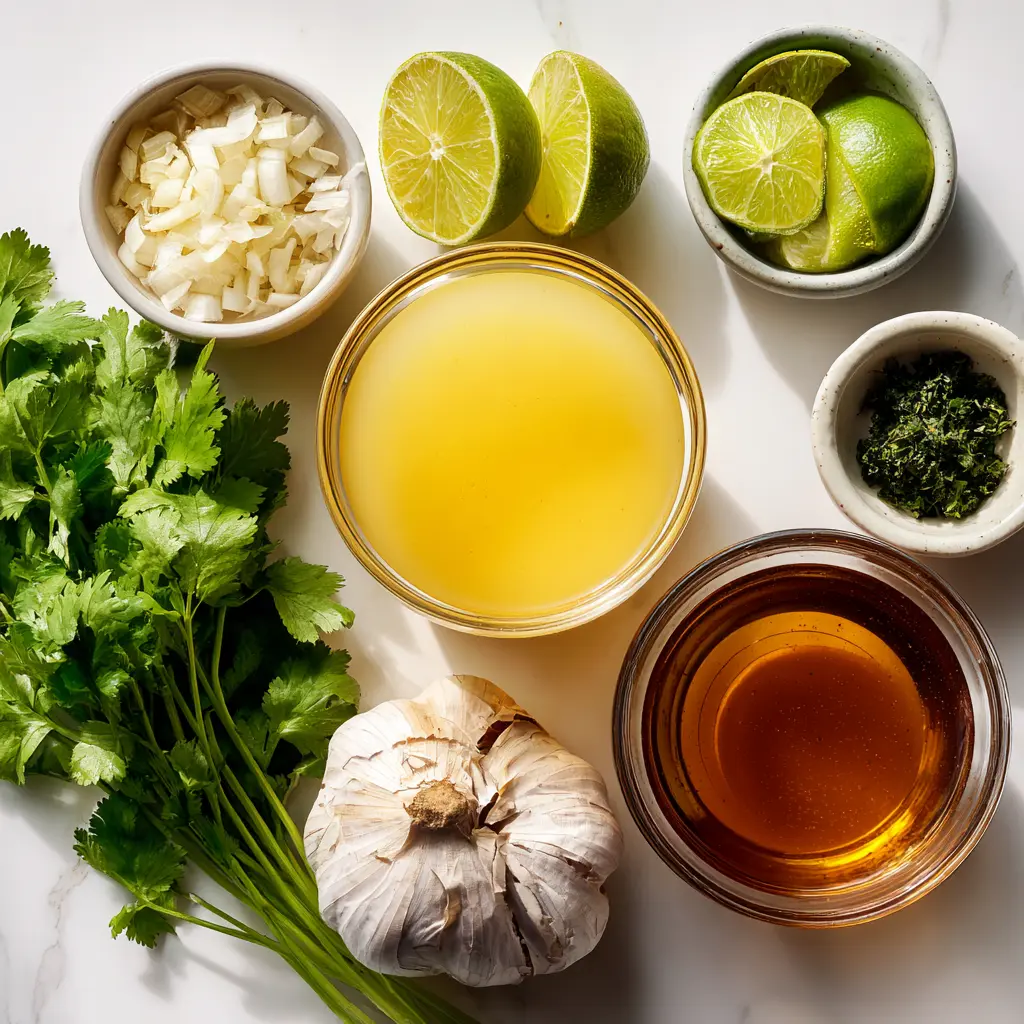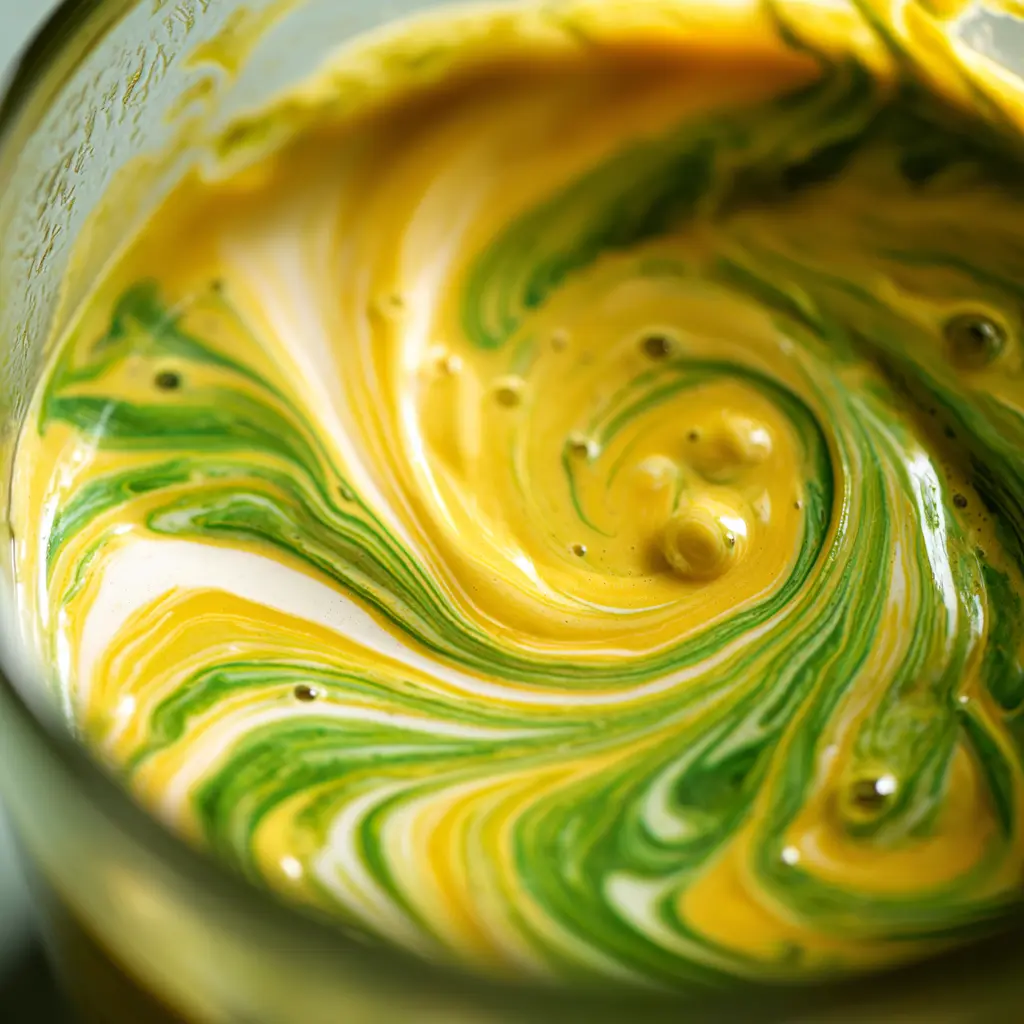If you’ve been hunting for a bold, citrus-packed flavor that instantly transforms any seafood dish, the leche de tigre recipe is your golden ticket. Known as “tiger’s milk” in English, this spicy, tangy Peruvian marinade is what gives ceviche its unmistakable zing — and once you try it, there’s no turning back.
My first encounter with leche de tigre was in the heart of Lima. I was handed a small glass of a cloudy, white liquid with no explanation — just a smile from the street vendor. “Tiger’s milk,” he said. One sip in, I was hooked. It was a wild rush of lime, garlic, chili, and fish essence. Zesty, spicy, refreshing. Nothing else like it.
But this isn’t just a story about a drink—it’s a deep dive into one of Peru’s most celebrated culinary staples. In this guide, we’ll walk you through everything you need to master the perfect leche de tigre recipe—from ingredients and preparation to serving ideas, health benefits, and expert tips.
Understanding Leche de Tigre
What Is leche de tigre recipe and Why Is It So Popular?
leche de tigre recipe — or “tiger’s milk” — is the flavorful, citrus-heavy marinade traditionally used to cure seafood in Peruvian ceviche. It’s known for its cloudy, white appearance (hence the “milk” in its name) and an unforgettable flavor that walks the line between tangy, spicy, and umami-rich.
But in Peru, this isn’t just some leftover liquid you toss after making ceviche. It’s the heart of the dish. Made from lime juice, fish stock, garlic, onions, cilantro, and Peruvian chilies, it’s blended into a bold concoction meant to awaken the palate and energize the body. Some even claim it cures hangovers or boosts vitality — giving rise to its nickname, “tiger’s milk.”
It’s often served by itself, in a chilled shot glass, or drizzled over seafood appetizers as a punchy dressing. And once you’ve tried it, you’ll understand why it’s become a symbol of Peruvian culinary pride around the world.
The Cultural Significance of Tiger’s Milk in Peruvian Cuisine
To truly understand the leche de tigre recipe, you need to look beyond the ingredients and into the kitchens of Peru.
In Lima and along the Peruvian coast, it’s not uncommon to find people sippingleche de tigre recipe straight from a glass. It’s considered a restorative elixir, often enjoyed mid-day or before a big meal. Street vendors, upscale restaurants, and home cooks all have their own takes — some spicier, some richer, some with a twist of coconut or shellfish reduction.
But regardless of variation, its role in Peruvian cuisine is foundational. It’s more than just a marinade for raw fish. It’s a reflection of the country’s biodiversity and bold culinary spirit. The use of citrus, chili, and fresh herbs is a hallmark of Peruvian cooking, andleche de tigre recipe ties it all together in one beautifully zesty experience.

Leche de Tigre (Peruvian Tiger’s Milk)
Ingredients
Equipment
Method
- Pour the fresh lime juice and cold fish stock into a blender to form the base of the marinade.
- Add garlic, shallots, celery, cilantro stems, and sea salt to the blender.
- Incorporate the grated ginger, ají amarillo paste, and optional chili pepper for heat.
- Blend everything until fully smooth and pale in color. The texture should be creamy with herbal flecks.
- Taste and adjust seasoning with more stock, salt, or lime juice as needed.
- Chill in the refrigerator for 15–20 minutes to allow flavors to meld before serving.
Nutrition
Notes
Tried this recipe?
Let us know how it was!Essential Ingredients for the Best Leche de Tigre Recipe
Core Ingredients and Their Role

When making an authentic leche de tigre recipe, everything starts with freshness. The ingredients you choose will define whether your marinade sings with bright citrus notes or falls flat. Luckily, the base is simple and accessible — but every part plays a role in creating that signature Peruvian zing.
Here’s a quick breakdown of the key components:
| Ingredient | Purpose in the Recipe |
|---|---|
| Fresh Lime Juice | The acidic backbone; “cooks” the seafood and gives that tangy punch. |
| Fish Stock | Adds depth, umami, and rounds out the sharp lime flavor. |
| Garlic & Shallots | Create aromatic complexity and subtle heat. |
| Celery | Provides a clean, crisp, refreshing layer. |
| Ginger | Adds warm spice and livens the acidity. |
| Cilantro Stems | Infuses the liquid with earthy, herbal notes. |
| Sea Salt | Balances and enhances every flavor. |
The quality of these ingredients is critical. Use freshly squeezed lime juice — bottled won’t cut it. For the fish stock, choose a clear, homemade or high-quality option with no added preservatives. The final result should taste bold, layered, and slightly creamy, even without dairy.
Check out our bold and refreshing salmon and rice recipe for another lime-forward seafood dish that complements leche de tigre beautifully.
Spotlight on Ají Amarillo and Customization Options
If there’s one ingredient that takes your leche de tigre recipe from good to unforgettable, it’s ají amarillo — a vibrant yellow Peruvian chili pepper that brings sweet heat and color. It’s fruity, floral, and moderately spicy, striking a perfect balance with lime and herbs.
Can’t find it fresh? No problem. You can substitute with:
- Ají Amarillo Paste (available in Latin or international grocery stores)
- A combo of yellow bell pepper + mild chili flakes or powder
- Or even a mild habanero, if you’re feeling adventurous (but use sparingly!)
Now, if you’re customizing your leche de tigre recipe for specific dietary needs or flavor preferences, here are some creative tweaks:
| Customization | How to Apply It |
|---|---|
| Vegetarian or Vegan Version | Replace fish stock with umami-rich vegetable broth. |
| Thicker Consistency | Add 1 tsp cornstarch slurry or blend with avocado or carrot. |
| Sweeter Notes | Balance tartness with a dash of orange juice or agave nectar. |
| Extra Spicy | Include serrano or habanero peppers (deveined for control). |
Want to pair it with something hearty yet mellow? Check out our comforting easy chicken pot pie recipe — the creamy filling contrasts beautifully with the bright, acidic leche de tigre recipe as a side drizzle.
Step-by-Step leche de tigre Recipe Instructions
Preparing the Base: Lime Juice and Fish Stock
Let’s get into the heart of this leche de tigre recipe — the moment where all those vibrant ingredients come together in one bold, zesty blend.
Start with freshly squeezed lime juice — about 1¾ cups. This forms the sharp, citrusy foundation of the marinade. Avoid bottled lime juice at all costs; it simply doesn’t have the same brightness or acidity.
To balance the lime’s bite, pour in 1¼ cups of cold fish stock. This adds body and umami, giving the leche de tigre recipe its savory backbone. If you’re making a vegetarian version, substitute with a rich vegetable broth that includes mushrooms or seaweed for added depth.
Now, toss the following into a blender:
- 2 garlic cloves
- 2 tablespoons chopped shallots
- 2 tablespoons chopped celery
- ½ cup chopped cilantro stems
- 1 teaspoon sea salt
No need for precision chopping — it’s all getting blended anyway. These ingredients create the base layer of flavor before we introduce the star spice.
Balancing Flavors and Heat: Chili, Ginger, and Cilantro

Now it’s time to elevate this mixture from citrusy to complex. Add the following:
- 1 tablespoon grated fresh ginger – this brings gentle heat and sharpness
- 1 tablespoon ají amarillo paste – the soul of your leche de tigre
- Optional: ½ small serrano or habanero pepper (for those who want more fire)
Secure your blender lid and pulse until everything is fully liquified. The final result should look pale and cloudy, almost creamy — with visible flecks of herbs and a smooth texture.
Here’s a pro tip: strain the mixture through a fine mesh sieve for a cleaner finish if you’re serving it as a drink or shooter. Otherwise, leave it unstrained if using as a marinade or sauce to keep all the rich flavors.
Taste your leche de tigre. Too sharp? Add a splash more stock. Not spicy enough? Another touch of ají amarillo will fix that. Need a balance? A small squeeze of orange juice can round things out.
Once you’re happy with the flavor, chill the mixture for at least 15–20 minutes. This resting period lets all the flavors settle and marry beautifully.
Pro Tips for the Perfect leche de tigre Every Time
| Tip | Why It Matters |
|---|---|
| Use ice-cold ingredients | Enhances freshness and slows separation |
| Strain if serving as a drink | Improves texture and appearance |
| Adjust salt last | The lime may intensify flavor after chilling |
| Chill before using | Sharpens flavor and thickens slightly without additives |
How to Use leche de tigre recipe in Dishes
Traditional Ceviche with Leche de Tigre

If there’s one dish that perfectly showcases the brilliance of the leche de tigre recipe, it’s ceviche. In fact, many would argue that without this citrusy marinade, ceviche simply wouldn’t exist.
To prepare a classic ceviche using leche de tigre:
- Choose ultra-fresh white fish like sea bass, halibut, or snapper.
- Dice it into small cubes, ensuring consistent size for even “cooking.”
- Pour cold leche de tigre over the fish and let it marinate for 5–10 minutes.
- Garnish with thin red onion slices, fresh cilantro, and sliced chili (optional).
The lime juice in the marinade gently cures the fish, changing its texture and color. Meanwhile, the ginger, garlic, and ají amarillo bring warmth and complexity. Serve chilled with sliced sweet potatoes, cancha (toasted corn nuts), or lettuce leaves for an authentic Peruvian presentation.
Want to serve it with something hearty? Don’t miss our ultimate country-style beef ribs recipe as a bold, meaty contrast to the lightness of ceviche.
Creative Culinary Uses Beyond Ceviche
The leche de tigre recipe is far more versatile than most people realize. Once you’ve mastered the base, use it as a secret weapon across your menu. Here are a few creative ways to bring its tangy magic into unexpected dishes:
1. Drizzle Over Grilled Seafood
Use it like a citrusy glaze for grilled shrimp, scallops, or octopus. The acid balances the char, while the herbs add a fresh finish.
2. Dipping Sauce for Fried Foods
Fried calamari, fish tacos, or even crispy yucca fries get an instant upgrade with a small bowl of chilled leche de tigre on the side.
3. Bold Salad Dressing Base
Blend with olive oil and a touch of honey for a zesty vinaigrette that transforms simple greens or seafood salads into something special.
4. Cold Shot Appetizer
Serve in a shot glass with a skewer of shrimp or a thin sliver of fish. It’s a flavor bomb — and a conversation starter — at any dinner party.
Side Dishes and Pairings That Work With Leche de Tigre
Classic Sides: Sweet Potato, Cancha, and Plantains
Whether you’re serving it in a bowl of ceviche or as a dipping sauce, no leche de tigre recipe is complete without thoughtful accompaniments. These aren’t just side dishes — they’re traditional components that balance the intensity of tiger’s milk with sweetness, crunch, or creaminess.
1. Sweet Potato Slices (Camote)
Boiled or roasted sweet potatoes provide a naturally sweet contrast to the bright acidity of the leche de tigre. This pairing is a Peruvian classic. Slice thinly and serve slightly warm — their soft texture and mild flavor mellow the heat and acidity beautifully.
2. Cancha (Toasted Corn Nuts)
This crunchy corn snack adds texture and a touch of salt, which brings out the limey sharpness in the marinade. Cancha is traditionally served alongside ceviche and offers the perfect bite between spoonfuls.
3. Fried Green Plantains (Tostones)
If you want a Caribbean-inspired twist, tostones offer a starchy, golden-fried option that holds up well to dipping in leche de tigre. They’re crispy on the outside, tender inside — and they soak up the citrusy broth beautifully.
Want something rich and cheesy on the side? Check out our gooey cheesy ground chicken pasta as a creamy comfort dish to contrast the zesty bite of leche de tigre.
Perfect Beverages to Serve Alongside
A sharp, spicy leche de tigre recipe deserves drinks that complement, cool, or contrast the flavor. Here are a few winning pairings for any occasion — casual or festive:
1. Pisco Sour
This classic Peruvian cocktail, made from pisco, lime juice, and egg whites, mirrors the acidity of the marinade while offering a frothy, slightly sweet edge. It’s a top-tier pairing.
2. Chilled Herbal Iced Tea
Mint or lemongrass iced tea calms the palate after spicy bites. It’s also caffeine-free, making it a great option for daytime entertaining.
3. Sparkling Citrus Water or Limeade
Non-alcoholic and bubbly, these drinks enhance the lime in leche de tigre while refreshing your palate between sips or bites.
Health Benefits and Nutritional Considerations
Nutritional Highlights of Leche de Tigre Ingredients
While the leche de tigre recipe is best known for its bold flavor, it also delivers a surprisingly impressive range of nutritional benefits. Thanks to its base of fresh, whole ingredients, every sip or spoonful contributes to a healthy diet — all without added sugars, preservatives, or heavy fats.
Here’s a breakdown of the key components that make this Peruvian marinade both delicious and nourishing:
| Ingredient | Health Benefit |
|---|---|
| Lime Juice | Packed with vitamin C; supports immune function and promotes healthy skin |
| Fish Stock | Contains protein, collagen, and minerals that aid digestion and joint health |
| Ginger | Offers anti-inflammatory effects and helps with digestion |
| Garlic | A natural immune booster; may support heart and circulatory health |
| Cilantro | Loaded with antioxidants and may assist in natural detoxification |
| Ají Amarillo | Contains capsaicin, which may boost metabolism and support heart health |
Because it’s naturally low in calories, free of added sugar, and typically dairy- and gluten-free, leche de tigre fits well into several dietary lifestyles — including keto, low-carb, paleo, pescatarian, and gluten-free.
According to the Harvard T.H. Chan School of Public Health, fish and citrus-based dishes like this are rich sources of nutrients that support heart and brain health when consumed as part of a balanced diet.
Looking for another health-conscious dish? Explore our vibrant lamb lentils recipe — a high-protein meal that balances perfectly with leche de tigre’s acidic notes.
Best Practices for Safe Preparation with Raw Fish
While leche de tigre itself is safe and nutritious, it’s often used in recipes like ceviche that involve raw or lightly cured fish. That means following a few simple, but essential, safety steps is crucial.
Tips for Safe Preparation:
- Use sushi-grade fish whenever possible. It’s been frozen to kill parasites.
- Buy from reputable seafood markets and use fish the same day it’s purchased.
- Keep your marinade and fish cold at all times — under 40°F (4°C).
- Marinate just before serving. Avoid long soaking times if not consuming immediately.
- Store leftovers for no more than 24–48 hours, and discard anything with a fishy smell.
If you’re concerned about using raw fish but still want the flavor of ceviche, try lightly blanching the seafood before adding leche de tigre. It won’t be traditional, but it’s a safer compromise for immune-sensitive eaters or kids.
Expert Tips and Global Variations
How to Thicken and Balance the Marinade
One of the most frequently asked questions from both home cooks and culinary pros is how to adjust the texture and flavor of their leche de tigre without compromising authenticity. Whether you’re serving it as a shooter, a dip, or a ceviche marinade, consistency and taste matter.
Here are several tried-and-true tips straight from Peruvian kitchens and chefs worldwide:
Thickening Techniques
- Cornstarch Slurry: Add a small amount (½ tsp cornstarch + 1 tsp cold water) and simmer briefly until slightly thickened. This works best if using the leche de tigre as a sauce.
- Blended Veggies: Blend in a bit of avocado, sweet potato, or even yellow bell pepper to add natural creaminess without altering the flavor dramatically.
- Use Less Stock: If your marinade feels too thin, simply reduce the amount of fish or vegetable stock while keeping the lime juice ratio high.
Balancing Acidity
- Add Sweetness: A splash of orange juice or a drizzle of honey can help tame sharp lime notes.
- Boost Umami: A dash of soy sauce or a few drops of fish sauce can add savory depth without making the dish salty.
- Chill Before Tasting: Remember that cold temps mellow acidity and saltiness, so taste after chilling to get an accurate flavor profile.
Discover great ideas like our creole butter turkey breast recipe for sauces and flavor layering techniques that pair well with citrus-forward marinades like leche de tigre.
International Twists: Coconut Milk, Smoked Peppers & More
While the traditional leche de tigre recipe is rooted in Peru, chefs around the globe have started putting their own spin on it — creating modern fusions that cross culinary borders.
Popular Global Variations
- Coconut Leche de Tigre (Tropical Fusion)
- Add a splash of coconut milk to create a creamy, Caribbean-inspired version. Works especially well with shrimp or scallops.
- Smoked Chili Leche de Tigre (Mexican Influence)
- Replace or complement ají amarillo with chipotle or guajillo chili paste for a smoky twist.
- Japanese-Peruvian Nikkei Style
- Add a dash of yuzu juice and a few drops of soy sauce or miso for an umami-rich, Asian fusion.
- Brazilian-Inspired
- Use lime and cashew fruit juice (caju) for a sweet, fruity variation with grilled seafood.
These global adaptations respect the heart of the dish while allowing creativity to shine. The key is to preserve the bold acidity and herbaceous undertone while adjusting texture, spice, or sweetness to suit your regional taste.
Want to explore more fusion flavors? Try our globally inspired churro cheesecake as a bold dessert following a Latin-American themed dinner.
FAQs
What does leche de tigre taste like?
Leche de tigre has a bright, bold, and complex flavor. The dominant taste is tangy lime, followed by savory depth from the fish stock, a gentle heat from ají amarillo or other chili peppers, and earthy freshness from herbs like cilantro. Depending on the exact blend, it may also have a hint of sweetness or sharpness from ginger and shallots.
The overall flavor is zesty, spicy, slightly creamy, and incredibly refreshing — especially when served chilled. It’s not just a sauce; it’s a punchy flavor experience.
Why is it called tiger’s milk?
The name “leche de tigre” — which translates to “tiger’s milk” — refers to its cloudy white appearance, which resembles milk, and its fierce, energizing flavor. In Peruvian culture, it’s also associated with strength and virility.
Locals believe this citrusy liquid revitalizes the body, cures hangovers, and even boosts libido — earning its exotic, powerful nickname.
What is the difference between leche de tigre and ceviche?
While they are closely linked, leche de tigre and ceviche are not the same.
Leche de tigre is the marinade, made from lime juice, fish stock, herbs, and spices.
Ceviche is the dish, which involves soaking raw fish or seafood in leche de tigre to cure it.
Think of leche de tigre as the flavorful liquid foundation that gives ceviche its character — but it’s also served on its own, used in dressings, or enjoyed as a shot.
How long is leche de tigre good for?
Freshly made leche de tigre is best enjoyed the same day, especially if you’re using it to cure raw seafood. However, if stored in an airtight container in the refrigerator, it can last up to 2 days.
Keep in mind that the flavors intensify over time, and the acidity may break down herbs or chili, slightly altering the taste. For the freshest, most vibrant result, make it in small batches and use it cold.
Is leche de tigre good for you?
Yes — the leche de tigre recipe has several nutritional benefits. Here’s why:
Lime juice is rich in vitamin C, which supports the immune system.
Fish stock offers protein, collagen, and minerals.
Garlic, ginger, and cilantro all have antioxidant and anti-inflammatory properties.
It’s a low-calorie, nutrient-rich marinade that can be part of a healthy, balanced diet — especially when paired with lean seafood and fresh veggies.
How do you eat leche de tigre?
There are several ways to enjoy leche de tigre:
Poured over ceviche, letting it cure the fish.
Served as a cold shooter, often with a slice of seafood in the glass.
Drizzled on grilled or fried seafood as a flavorful finish.
Used as a dipping sauce for plantains, calamari, or fish tacos.
Mixed into seafood cocktails for a bold, tangy twist.
Conclusion: Bring the Leche de Tigre Recipe to Life in Your Kitchen
The leche de tigre recipe is more than just a marinade — it’s a bold expression of Peruvian culinary heritage. With just a handful of fresh, vibrant ingredients, you can create a flavor that’s equal parts tangy, spicy, and savory. Whether you’re making traditional ceviche or experimenting with modern twists, leche de tigre brings energy and depth to every dish it touches.
What makes this recipe so special is its versatility and adaptability. It’s simple enough for a quick weeknight meal yet impressive enough for a gourmet dinner party. And the best part? Once you master the basics, you can adjust it endlessly to suit your taste, your mood, or your menu.
So now it’s your turn.
Grab some fresh limes, pick your peppers, and start blending. Let the flavors of Peru come alive in your kitchen. Whether served as a marinade, a shooter, or a dressing, this fierce and flavorful “tiger’s milk” is sure to make a lasting impression.
Looking for more bold, creative dishes? Don’t miss our cheesy chicken sloppy joes recipe — a comfort food classic with its own punch of flavor.





